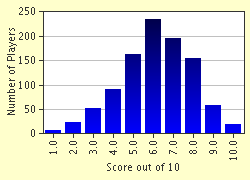Quiz Answer Key and Fun Facts
1. What is the name of the pigment that gives the green colour to plants?
2. This metal oxide is often added to paint to make it bright white.
3. What is the pigment in the skin of oranges that gives it the orange colour?
4. Henna has been used since ancient times to dye hair. But what is the compound present in henna that creates the red colour?
5. What is the name of the pigment present in hair that gives it a dark colour?
6. This dye can be obtained from the woad plant and has been used for centuries as a blue colourant.
7. What is the name of the pigment that gives tomatoes their red colour?
8. The gemstones ruby and sapphire are both forms of aluminium oxide - alumina (Al2O3). Their different colours are caused by metal ion impurities replacing aluminium ions at random points throughout the structure. Which metal ion impurity is responsible for ruby's red colour?
9. This expensive spice results in a beautiful golden yellow colour and is used not only in food, but also as a dye.
10. What is the name of the red stain obtained from cochineal insects?
Source: Author
NatalieW
This quiz was reviewed by FunTrivia editor
crisw before going online.
Any errors found in FunTrivia content are routinely corrected through our feedback system.

